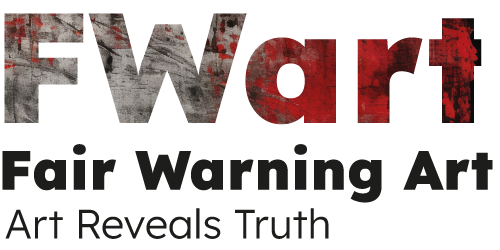Fair Warning Art arises from the urgent need for an art form that goes beyond mere beautification, tearing away the veil of ignorance to reveal the uncomfortable truths hidden behind power structures. This movement does not seek to entertain or console; instead, it aims to expose, to transform indignation into creation, and apathy into action. This is our cry of alarm.
The fundamental reasons for the existence of Fair Warning Art are based on profound philosophical and ethical convictions:
- Art is considered an essential manifestation of the human condition and a powerful tool for social critique and transformation.
- Inspired by theories of social critique and emancipatory thought, Fair Warning Art believes that art must transcend aesthetics to actively engage with the surrounding reality.
- Influenced by thinkers like Michel Foucault and Jürgen Habermas, the movement asserts that knowledge is not neutral. Art, in its capacity to represent and question, can unveil hidden power relations and confront hegemonic narratives through a critical epistemology. Its goal is to dismantle structures that perpetuate inequality and injustice.
- Guided by Hans Jonas’s ethics of responsibility, Fair Warning Art recognizes the moral obligation to act in the face of ecological, social, political, and economic crises. Art is not merely personal expression but a collective responsibility to illuminate, question, and transform.
- The manifesto rejects the notion of superficial beauty imposed by power structures. It advocates for an aesthetic of truth that values veracity, authenticity, and the capacity of art to reflect and challenge reality. Each work is an act of resistance against distortion and manipulation.
The vision and mission of Fair Warning Art also explain its raison d’être:
- It stands as a symbolic barricade, a space where research, journalism, and creativity converge to materialize denunciation.
- Its vision is of a society where art acts as a catalyst for change, fostering a critical collective consciousness and ethical action towards a more just and sustainable future.
The principles of Fair Warning Art further detail its motivations:
- Art must expose the hidden truths behind the harmful actions of corporations and governments.
- All expressions are based on verified research and solid data to combat misinformation.
- There is a commitment to direct and uncensored denunciation of harmful practices.
- It recognizes that every artistic creation is a political statement and is used as a form of active resistance against unjust power structures.
- It seeks to connect emotion and consciousness, transforming abstract data into profound emotional experiences that provoke empathy, indignation, and action.
- It values the diversity of voices and styles, recognizing that truth takes many forms.
- It declares autonomy from corporate or governmental interests, with loyalty solely to the truth and citizen empowerment.
- Art should be a call to action, inspiring real changes.
- It promotes the transparency and accessibility of messages.
- It believes in the transformative power of truth to generate profound social change.
Finally, Fair Warning Art is committed to social, economic, and environmental justice, addressing issues such as economic inequality, labor exploitation, environmental degradation, and the climate crisis. It seeks to analyze and question the economic systems that perpetuate inequality and promote solidary and sustainable economic models. The movement also aims to interact with the community, promote dialogue, and use art as a tool for education and awareness. Innovation and artistic experimentation are valued to challenge conventions and explore new forms of communication.
In summary, Fair Warning Art represents a commitment to an ethically and philosophically grounded truth through creative action. It is art as conscious resistance, an alert that not only sparks but also inspires and mobilizes. Fair Warning Art is its creative response to the injustices of our time, a manifestation of hope, and a call to action to build a more just, conscious, and economically equitable future.
Fair Warning
The expression “Fair Warning” is taken from the organization, with the same name.
According to the University of Illinois site;
“FairWarning was a nonprofit investigative news organization with a focus on public health, consumer, workplace, and environmental issues, and related topics, and related topics of government and business accountability. FairWarning began publication in March 2010 and was a member of the Institute for Nonprofit News. FairWarning donated its website to the University of Illinois at Urbana-Champaign University Archives in the Fall of 2021”
Reference 04/14/2025: https://wayback.archive-it.org/16877/20210929142827/https://www.fairwarning.org/
